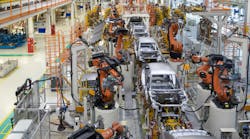The manufacturing sector contracted in April after one month of expansion following 16 consecutive months of contraction, according to the latest Manufacturing ISM Report On Business released on May 1.
"The U.S. manufacturing sector dropped back into contraction after growing in March, the first time since September 2022 that the sector reported expansion," said Timothy R. Fiore, "Although demand improvement slowed, output remains positive and inputs stayed accommodative. "
The Manufacturing PMI registered 49.2% in April, down 1.1 percentage points from the 50.3% recorded in March.
"Demand remains at the early stages of recovery, with continuing signs of improving conditions," says Fiore." Production execution continued to expand in March, but at a slower rate of growth than in prior months. Suppliers continue to have capacity but work to improve lead times, due to their raw material supply chain disruptions. Thirty-four percent of manufacturing gross domestic product (GDP) contracted in April, up from 30 percent in March. More importantly, the share of sector GDP registering a composite PMI calculation at or below 45% — a good barometer of overall manufacturing weakness — was 4% in April, higher than the 1% figure in March, but an indication of better health than the 27% recorded in January. Among the top six industries by contribution to manufacturing GDP in April, none had a PMI at or below 45%."
The overall economy continued in expansion for the 48th month after one month of contraction in April 2020.
Specific index performances are as follows:
- Supplier Deliveries Index figure of 48.9% is 1 percentage point lower than the 49.9% recorded in March.
- Inventories Index registered 48.2%, the same reading as in March.
- New Orders Index moved back into contraction territory after one month of expansion, registering 49.1%, 2.3 percentage points lower than the 51.4% recorded in March. T
- Production Index is 51.3% which is 3.3 percentage points lower than March's figure of 54.6 percent. T
- Prices Index registered 60.9%, up 5.1 percentage points compared to the reading of 55.8% in March.
- The Backlog of Orders Index registered 45.4%, down 0.9 percentage point compared to the 46.3% recorded in March.
- New Export Orders Index reading of 48.7 % is 2.9 percentage points lower than the 51.6% registered in March.
- The Imports Index continued in expansion territory, registering 51.9 %, 1.1 percentage points lower than the 53% reported in March and February. In the last three months,
- The Employment Index registered 48.6%, up 1.2 percentage points from March's figure of 47.4%.
What Respondents are Saying:
- "Conditions are improving as demand is starting to recover. Costs continue to be a major concern as suppliers that rapidly increased prices in the follow-up from COVID-19 are slow to return to pre-pandemic levels." [Chemical Products]
- "Sales continue to exceed expectations in 2024. The forecasted dip in commercial vehicle production volumes appears to be avoided. Operational output is still strong, and the supply chain has the capacity to support. International supply chain risks have been minimized, but the frequency of supplier insolvencies or bankruptcies appears to be increasing." [Transportation Equipment]
- "Order flow has stabilized. It took some customers longer to replenish their supply chain network after the fourth-quarter rush we commonly have. Order rates are expected to remain stable through August." [Food, Beverage & Tobacco Products]
- "Some small indications of market improvement in China for our instruments and technology. Recovery is still slower than we had hoped, and macroeconomic uncertainty remains in Europe and the Middle East, as well as domestically in the U.S. with ongoing inflationary pressures and anticipation for the (upcoming) election." [Computer & Electronic Products]
- "Market conditions have definitely softened. Thankfully, our backlog is strong and will get us through the year. When conditions improve as expected later this year, we will be in a good position to continue building the business. We are a manufacturer of automated packaging equipment for the food and beverage industry, and with a continued shortage of workers, our customers are requiring more and more automation." [Machinery]
- "Business is slowing down — it has been a gradual decline for the last several months. We are not seeing new orders at last year's level, or at this year's budgeted levels." [Fabricated Metal Products]
- "There has been a lot of volatility in sales. On average, our sales look flat, but the volatility is concerning." [Electrical Equipment, Appliances & Components]
- "Business remained strong through the first quarter and has started strong for the second quarter. Commercial construction is still going well but on a regional basis, with the Southeast the strongest." [Nonmetallic Mineral Products]
- "The major factor affecting our business is the uncertainty of the Federal Reserve's handling of interest rates, which will affect our customers' businesses, thereby affecting ours." [Plastics & Rubber Products]
- "Business is stable, and orders have been consistent. We're quoting new business for the factory, and automotive builds continue at averages but not near maximum outputs. Workforce is stable, with the turnover ratio dropping considerably. Salaries and hourly rates increasing to meet inflationary pressures." [Primary Metals]



